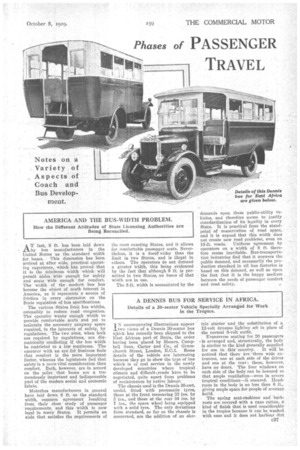Phases of PASSENGER
Page 75

If you've noticed an error in this article please click here to report it so we can fix it.
TRAVEL
AT last, 8 ft. has been laid down
• by bus manufacturers in the United States as the standard' width for buses. This dimension has been arrived at after wide, practical operating experience, which has proved that it 4s the minimum width which will permit aisles wide enough for safety and seats 'wide enough for comfort. The width of the modern bus has become the object of much interest in America, as it represents a source of friction in every discussion on the State regulation of bus specifications.
• The various States limit bus widths, ostensibly to reduce road congestion. The operator wants enough width to Provide comfortable seats and yet to maintain the necessary gangway space required, in the interests of safety, by
• regulations. The two aims, when both are required by regulations,are diametrically conflicting if the bus width be restricted to a low maximum. The
• operator with an eye fot business feels that comfort is the more important factor, whereas the legislators feel that safety is a more vital consideration than comfort. Both, however, are in accord on the poInt that buses are a tremendously important and indispensable part of the modern social and economic fabric.
Motorbus manufacturers in general have laid down 8 ft. as the standard width, common agreement 'resulting from their close study of passenger requirements, and this width is now legal in many States. It permits an aisle that satisfies the requirements of the most exacting States, and it allows for comfortable passenger seats. Nevertheless, it is a footO wider than the limit in two States, and is illegal in others. The operators do not demand a greater width, this being evidenced by the fact that although 9 ft. is permitted in two States, no buses of that width are in use.
The 8-ft. width is necessitated by the demands upon these public-utility Vehicles, and therefore seems to justify standardization of its legality in every State. It is practiCal from the standpoint of conservation of road space, and it is argued that this width does not create new road problems, even on 18-ft. roads. Uniform agreement by operators on a width of 8 ft. therefore seems inevitable. Bus-transportation industries find that it answers the public demand, and necessarily the production standard in all bus factories is based on this demand, as well as upon the fact that it is the happy medium between the needs of passenger comfort and road safety.




























































































































